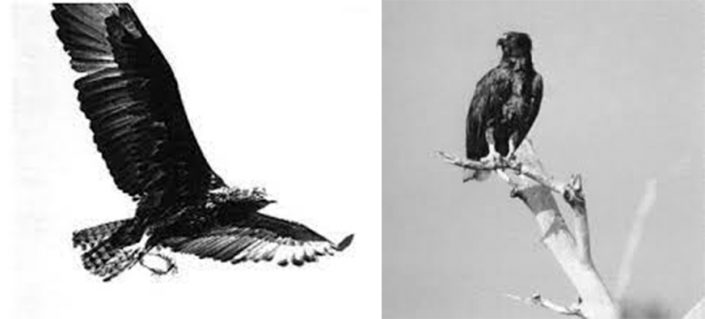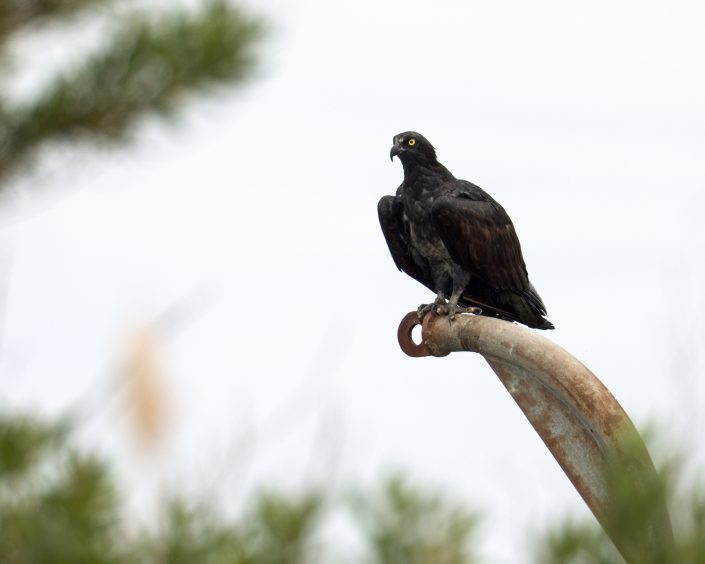Dark Star, the Oiled Osprey
A couple weeks ago colleagues with NJ Fish & Wildlife shared a video clip of a dark osprey who landed on a nest platform along the Maurice River near Leesburg, NJ. “Looks like an oiled bird” the text read. Indeed it looked like the bird was exposed to some form of petroleum product, which stained its feathers a dark color. At the time, there was no oil spill reported to NJDEP (this was on May 10) and the video shows that the bird was observed on the nest on May 1, 2021.
Then on May 12 a diesel fuel spill was reported on the Maurice River in Leesburg and reportedly was less than 778 gallons. It was caused by a malfunction with a fuel line which was refueling a supply vessel. Crew members from the U.S. Coast Guard and U.S. Fish and Wildlife Service responded to minimize impacts to the environmentally sensitive habitats of the Maurice River and Delaware Bay. The osprey in the video was exposed before May 12, so it seems likely that some other small spills occurred in the area.
Exposure to “oil destroys the insulating ability and water repellency of a bird’s feathers, thus exposing these creatures to the harsh elements,” which can cause them to die. In general, it reduces their overall health which leaves them vulnerable to disease and exposure to toxic substances which can result in death. It could also impair their ability to reproduce by transferring the contaminant to their eggs or young (we are not sure if this bird is part of a nesting pair).

Despite being exposed to potentially deadly amounts of a poisonous petroleum product, this osprey has survived. He has been observed in the area and photographed to show the extent of his oiled appearance as seen in the photos by Matt Reitinger last week, who observed him again over the MDW.
At first glance, the bird appears to be a dark morph or melanistic osprey, which is a very very rare variation of plumage observed in ospreys worldwide. It is so rare that there are no recent (digital) photos depicting such a rare osprey. They are only described in a couple journal articles and the most recent occurrence was in 2002 in Florida.
From one article: “From a distance, resting or in flight, the bird appeared to be generally dark chocolate-brown, suggestive of a first-year Bald Eagle (Haliaetus leucocephalus). We were able to study and photograph this individual, while it was perched, from a distance of 200 meters on 15 May 2002. The head, back, breast, and belly were dark brown with
a few scattered lighter brown feathers, in no obvious pattern. The feathers of the nape and rear crown were attenuated so when seen in profile the bird had the typical Osprey crest. Wings also were dark, but when seen from below some barring was apparent. The upper lesser wing coverts were lighter in color giving the bird a reddish-brown shoulder.
The tail was lighter with marked barring and appeared nearly normal. (Nesbitt, S. et al. Observations of a Melanistic Osprey in Southwest Florida. Florida Field Naturalist 31(2):23-24, 2003).

And in another article: “the head, underparts, and underwing coverts of this Osprey are dark brown, with some buffy markings visible on
the underparts. The head is uniformly dark; the black eye-line of Ospreys with normal plumage is not noticeable, even at close range.
The pale undersides of the flight feathers differ from those of normal Ospreys (Wheeler and Clark 1995) in that they lack any dark barring. The eye and leg colors and tail color and pattern are the same as those of normal Ospreys, as are its vocalizations (Clark, W. First North American Record of a Melanistic Osprey. Wilson Bull., 110(2), 1998, pp. 289-290).

I would love for this bird to be a dark morph osprey (I have seen a light morph osprey in NJ in the past), but it is not! This is an oiled osprey. First, the overall coloration is not representative of an osprey. This bird is more black than brown, which is from its exposure to the petroleum product. Second, the eye line or eye stripe is still visible. In the description of a true melanistic osprey, the eye stripe is not visible at all, since all the plumage is dark brown, which leads to my third point. The underparts (belly and upper legs) are still white, but are stained black. This is shown in the video when the bird lands. If the bird was truly a dark morph, then all body feathers would be dark except for the tail. Lastly, as mentioned by Clark, the light underwing barring is missing on melanistic ospreys, but this osprey has light barring on its underwing primary flight feathers. In addition, the chances of seeing a super rare dark morph, melanistic osprey at the same time and place of a known oil spill is simply unrealistic.
The Maurice River is a National Wild and Scenic River, which is a critical link between the Pinelands Reserve and the Delaware Bay. It is regarded as one of the most pristine coastal rivers along the Atlantic Coast. Its clean water are vital habitat for the migratory shorebirds, waterbirds, raptors, and fish. The watershed provides habitat for over 50% of the species listed as endangered or threatened in New Jersey. I truly hope this bird won’t be negatively affected by its exposure to the fuel in the Maurice River and all the other ospreys (50+ pairs) who nest along the river, which is home to New Jersey’s most productive osprey nesting colony.
Thank you to our US Coast Guard and US Fish & Wildlife staff who responded to this oil spill.
Leave a Comment
UGH! Once again, one of our precious birds has been negatively impacted by man’s “needs” and demands on the environment. I hope this bird can survive until it molts. Presumably new feathers will be clean and normal.
Ben, Thank you for this interesting blog post. I really hope this Osprey will survive. I realize it’s very difficult to catch an adult Osprey (though I believe Alan Poole and Rob Bierregard have been successful in the past), but is there any chance that it could be caught and cleaned?
Saw this bird first in the video posted above. He visited Terrapin Cove, which is a nature sanctuary sporting many live feeds of Osprey nests, among other things. We were hoping he would stick around, but the resident nesting male chased him off.
DarkStar was seen on cam several time at Terrapin Cove and seemed healthy at the time. Hope that is still the case. We thought then s/he might be a dark morph. Sad to learn the truth of it.
Here is another example of Brazos on the Maurice River.
https://www.youtube.com/watch?v=YLnrCZGTAO0
Ben, thank you so very much for all you do, always, for New Jersey birds in general (and their habitats!), and ospreys in particular. You truly are, in the best, ancient sense, the ‘godfather’ of these vulnerable magnificent creatures. Don’t I remember, from the BP OIL SPILL (now referred to as ‘The Deepwater Horizon’ brilliant, ominous tactic!) and the Exxon Valdez (not rechristened) that birds become ill from absorbing oil as they preen? I am hoping this fine creature survives – but does he need to be helped, washed, nourished or anything like that? Forgive my lack of knowledge, as I honor yours, always! Carolyn Edelmann, Lawrenceville
I observed this Osprey on June 4th at Heislerville. I have several photographs that I can send if you would like. We also thought it was melanistic
I can assure you that “Darkstar” is 100% not an oiled Osprey. My pics of it are from before any of the ones submitted and are over a month old along with more recent pics I just took yesterday. The bird is still black all over and happy and healthy as can be. If Zit wax oiled to the point of staining it that bad it would have died within 48 hrs with no question. My pics have all been confirmed by multiple experts and are being published in the magazines currently. It has been confirmed by multiple experts in the field as a Melanistic Osprey. This video is is insignificant and just an assumption. Unless you have an actual video of this bird diving into an oil spill and then flying away covered in oil then I find it troubling that this is released to the public with wrong information. My story will be coming out soon in the magazines with all of my close up perched pictures along with multiple flight pictures. 100% not oiled. This is information that you should know so people are getting the correct story
Comments are closed.